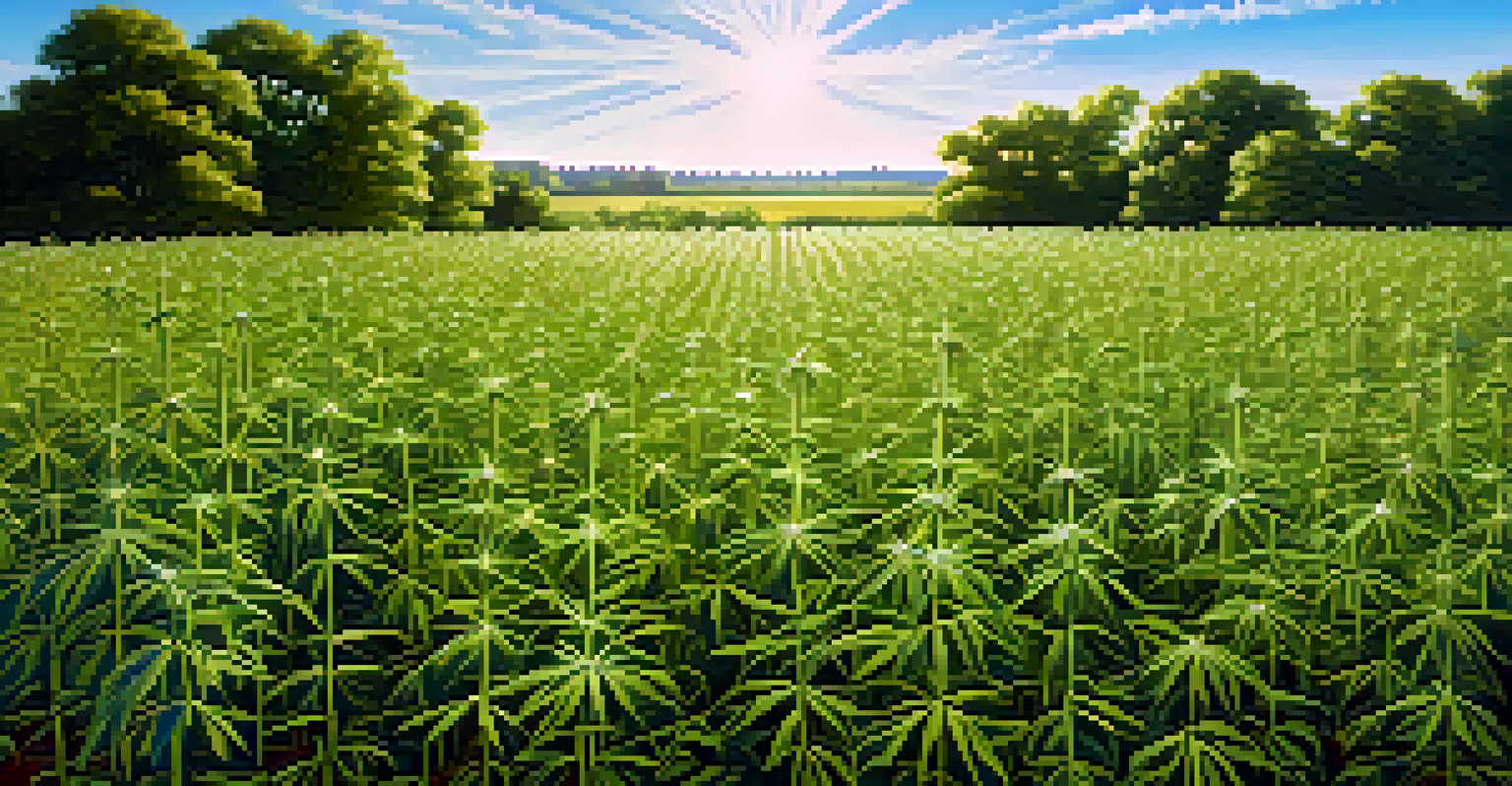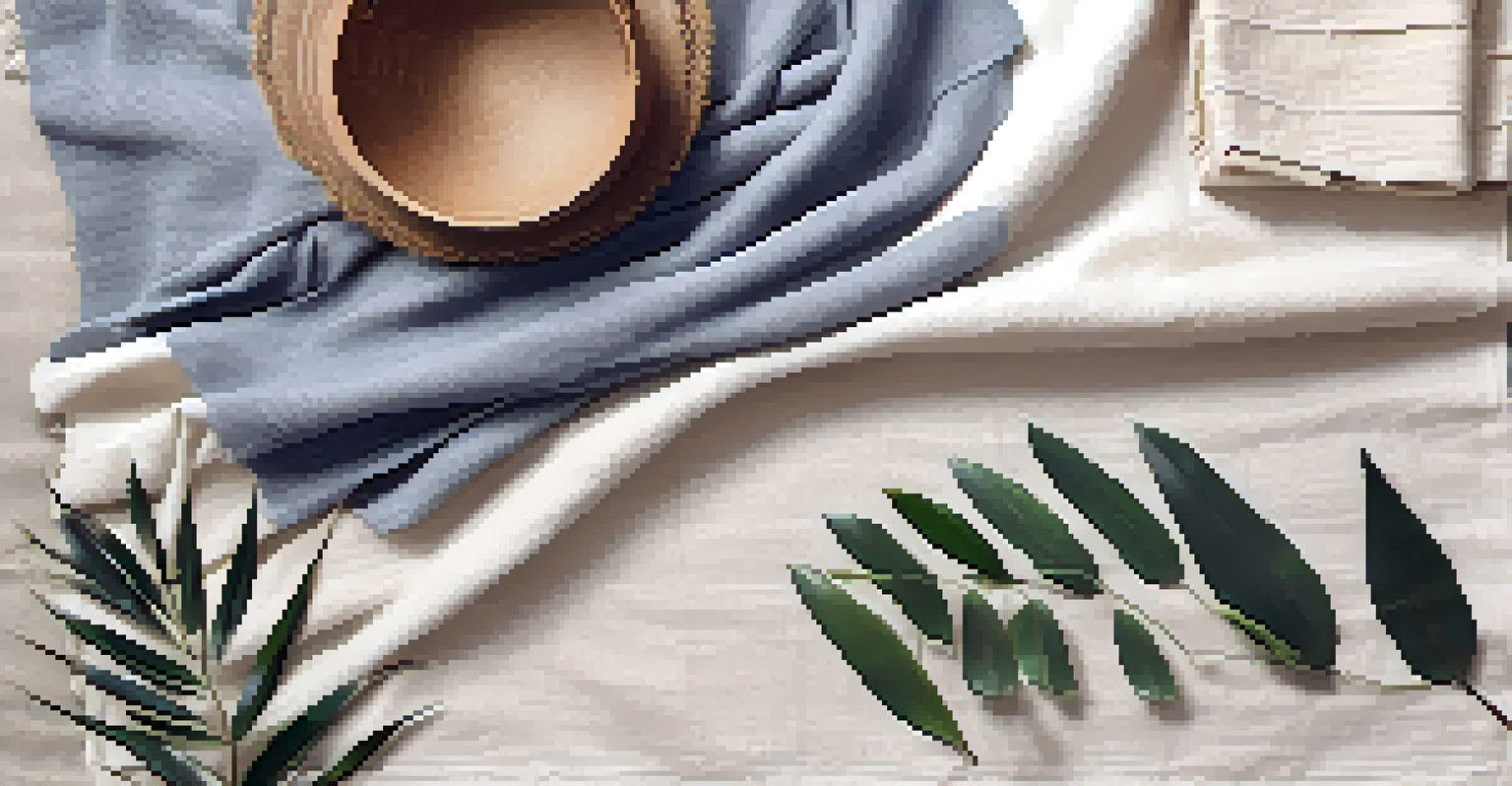From Hemp to Bamboo: Diverse Plant Fibers in Textiles

Understanding Plant Fibers: Nature's Textiles
Plant fibers are natural materials sourced from various parts of plants, including leaves, stems, and seeds. They have been used for centuries in textiles, offering a sustainable alternative to synthetic fibers. With a growing emphasis on eco-friendliness, these fibers are gaining popularity in the fashion industry.
The greatest threat to our planet is the belief that someone else will save it.
Among the most commonly used plant fibers are cotton, flax, hemp, and bamboo. Each of these fibers possesses unique properties, making them suitable for different applications. For instance, cotton is known for its softness, while hemp is celebrated for its durability and strength.
As consumers become more conscious about their choices, understanding these plant fibers can help in making informed decisions. This knowledge not only supports sustainability but also promotes a healthier planet.
Hemp: The Versatile Superfiber
Hemp is often hailed as a superfiber due to its remarkable versatility and sustainability. It grows quickly, requires little water, and is naturally resistant to pests, making it an environmentally friendly crop. These properties make hemp an excellent choice for textiles, contributing to a lower carbon footprint.

In textile production, hemp fibers are known for their strength and durability. They can last for years, resisting wear and tear, which is a significant advantage for clothing and home textiles. Moreover, hemp fabric becomes softer with each wash, enhancing comfort over time.
Plant Fibers: Eco-Friendly Textiles
Natural plant fibers like hemp, bamboo, and flax are becoming popular in the fashion industry due to their sustainability and unique properties.
Hemp's natural breathability and moisture-wicking properties make it ideal for a variety of garments, from casual wear to activewear. As the demand for sustainable fashion rises, hemp continues to carve out a niche in the textile industry.
Bamboo: The Eco-Friendly Alternative
Bamboo is another fascinating plant fiber that has gained traction in the textile world. Known for its rapid growth and minimal resource requirements, bamboo is a sustainable option that appeals to environmentally conscious consumers. It can thrive without pesticides and requires less water than cotton.
Sustainability is no longer about doing less harm. It’s about doing more good.
In terms of textile properties, bamboo fibers are incredibly soft and naturally antibacterial, making them ideal for clothing, bedding, and towels. The softness is often compared to silk, providing a luxurious feel against the skin. Additionally, bamboo textiles are breathable and moisture-wicking, making them suitable for various climates.
As brands look to differentiate themselves in a competitive market, bamboo textiles offer a unique selling point. Their eco-friendliness and comfort are attractive qualities that resonate with consumers seeking sustainable options.
Flax: The History Behind Linen
Flax fibers have been used for thousands of years, primarily to produce linen, one of the oldest textiles known to humanity. The cultivation of flax is a labor-intensive process, but the end result is a fabric that is highly valued for its breathability and moisture-wicking capabilities. Linen is particularly popular in warm climates due to its cooling properties.
One of the standout features of linen is its durability; it can withstand repeated washing and wear. Additionally, linen fabric becomes softer and more comfortable over time, making it a favorite for summer clothing and home textiles. Its natural luster adds an elegant touch to garments.
Hemp and Bamboo Lead Sustainability
Hemp and bamboo stand out for their rapid growth, low resource needs, and versatility, making them key players in the shift towards eco-friendly fashion.
As the trend moves toward sustainable fashion, linen is making a comeback. With its rich history and environmental benefits, flax demonstrates that ancient materials can still play a pivotal role in modern textile production.
Cotton: The Classic Choice
Cotton is perhaps the most recognized plant fiber in the world, known for its soft texture and versatility. It can be found in a wide range of products, from t-shirts to bed sheets. While cotton is beloved for its comfort, the traditional farming methods can be resource-intensive and harmful to the environment.
However, organic cotton is changing the narrative. Grown without harmful pesticides and fertilizers, organic cotton supports sustainable farming practices and biodiversity. By choosing organic options, consumers can enjoy the softness of cotton while contributing to a healthier ecosystem.
With a variety of weaves and finishes available, cotton remains a staple in the textile industry. Its adaptability and comfort ensure that cotton will continue to be a favorite for generations to come.
The Rise of Sustainable Textiles
The textile industry is undergoing a significant transformation as sustainability takes center stage. Consumers are increasingly seeking out eco-friendly materials, prompting brands to explore innovative fibers. Plant fibers like hemp, bamboo, and linen are leading the charge in this shift toward sustainable fashion.
Sustainable textiles not only reduce environmental impacts but also promote ethical production practices. Many brands are now prioritizing transparency in their supply chains, ensuring fair labor practices and responsible sourcing. This commitment to sustainability resonates with consumers who value ethical choices.
The Future is Plant-Based Textiles
As consumer awareness increases, the textile industry is evolving to prioritize plant-based materials, paving the way for a more sustainable future.
As awareness grows, the demand for sustainable textiles is expected to continue its upward trajectory. The future of fashion lies in embracing these natural fibers, paving the way for a healthier planet and a more responsible industry.
Innovations in Plant Fiber Textiles
Innovation is key in the evolution of plant fiber textiles. Brands are experimenting with blending different fibers to create fabrics that combine the best qualities of each. For example, blending hemp with cotton can enhance durability while maintaining softness, making it suitable for various applications.
Additionally, advancements in technology are enabling more efficient processing of plant fibers. Innovations such as water-saving techniques and eco-friendly dyes are minimizing the environmental impact of textile production. These developments ensure that plant fiber textiles can meet the growing demand for sustainable options.

As the industry continues to innovate, we can expect to see even more exciting advancements. The integration of technology with traditional plant fibers holds the potential to revolutionize the textile landscape, making it more sustainable and efficient.
The Future of Textiles: A Plant-Based Revolution
The future of textiles is leaning towards a plant-based revolution, with a growing emphasis on sustainability and eco-consciousness. As awareness of environmental issues rises, consumers are more inclined to choose textiles made from renewable resources. This shift is prompting brands to rethink their material choices.
The diverse range of plant fibers available offers endless possibilities for innovation and creativity in textile design. From hemp to bamboo, each fiber brings unique characteristics that can be harnessed to create high-quality products. This opens up new avenues for designers to explore sustainable fashion.
Ultimately, the movement toward plant-based textiles is not just a trend; it's a necessary evolution in the industry. As we embrace these natural materials, we contribute to a more sustainable future for textiles and the planet.